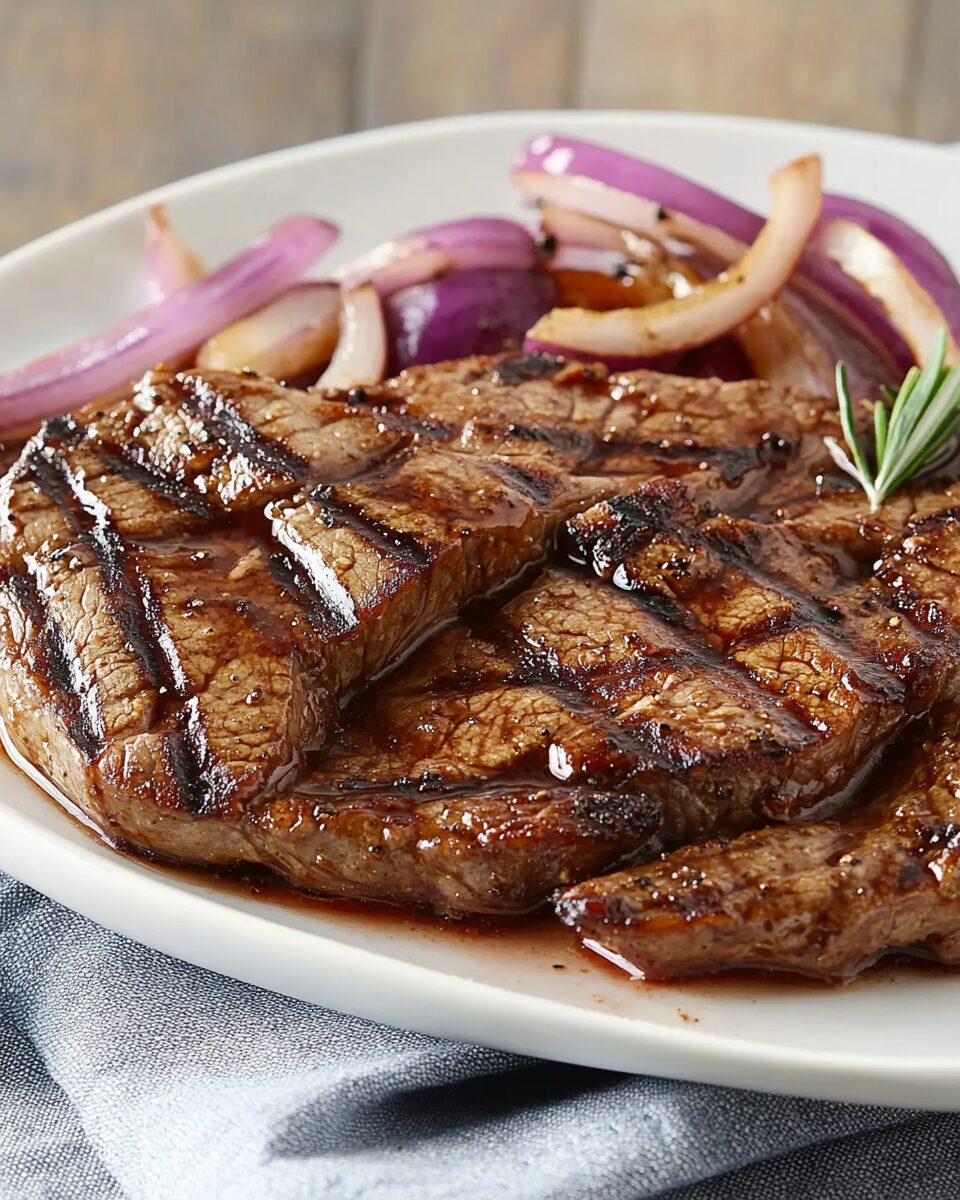Filipino Beef Steak, or “Bistek,” is a beloved comfort dish in Filipino cuisine. This recipe marries the flavors of citrusy lemon and savory soy, infusing tender slices of beef with a depth of flavor that’s both tangy and satisfying. The addition of caramelized onions and garlic enhances the richness of the dish, making it a delightful option for any meal.
The simplicity of Filipino Beef Steak allows the ingredients to shine, making it easy to prepare while still packing a flavorful punch. It’s a perfect choice for weeknight dinners, offering a taste of traditional Filipino home cooking. Enjoy this dish with steamed rice to soak up the delicious sauce!
Full Recipe:
- 1 lb beef sirloin, thinly sliced
- 1/4 cup lemon juice
- 1/4 cup soy sauce
- 1 tbsp sugar
- Salt and pepper, to taste
- 1 tbsp cornstarch
- 2 tbsp vegetable oil
- 1 large onion, sliced
- 3 cloves garlic, minced
- 1 tbsp olive oil
Directions:
- Place sliced beef in a large bowl. In a small bowl, whisk together lemon juice, soy sauce, sugar, salt, and pepper. Pour this marinade over the beef and toss to coat. Stir in cornstarch. Cover and refrigerate for at least 1 hour, or up to overnight.
- Heat vegetable oil in a large skillet over medium heat. Remove beef slices from the marinade, discarding excess liquid, and set aside. Discard the remaining marinade.
- Working in batches, fry beef slices in hot oil for 2-4 minutes per side, until they begin to firm up but remain tender and juicy in the center. Transfer the cooked beef slices to a serving platter.
- In a separate small skillet, heat olive oil over medium heat. Add the onion and garlic, cooking and stirring for 5-7 minutes until the onion turns golden brown. Spoon the onion and garlic mixture over the beef slices.
Prep Time: 15 minutes | Cooking Time: 15 minutes | Total Time: 30 minutes Kcal: Approximately 330 kcal per serving | Servings: 4
Exploring the Essence of Filipino Beef Steak (Bistek)
Filipino Beef Steak, known locally as “Bistek Tagalog,” is a celebrated dish in Filipino cuisine that brings together tender slices of beef, marinated and cooked in a blend of soy sauce and lemon juice. This combination yields a savory yet slightly tangy flavor profile that perfectly complements the rich taste of the beef. Traditionally served with caramelized onions, Filipino Beef Steak is a comforting and delicious meal that reflects the bold and straightforward flavors often found in Filipino home cooking.
The dish’s origins trace back to the Spanish colonial influence on the Philippines, during which various local adaptations of Spanish cuisine emerged. Filipino Beef Steak, while reminiscent of Western-style beef steak, is uniquely Filipino, with its use of soy sauce instead of Worcestershire sauce or other traditional steak seasonings. The addition of lemon juice (or calamansi in authentic Filipino recipes) gives it a bright acidity that balances the saltiness of the soy sauce. This blend of flavors makes Bistek a satisfying choice for family gatherings, weeknight dinners, or as a feature dish in Filipino restaurant menus worldwide.
The Cultural Significance of Filipino Beef Steak
In Filipino households, Bistek is more than just a meal; it’s a dish that brings people together. The simplicity of its ingredients and preparation makes it accessible, while its bold flavors create a sense of warmth and comfort that’s deeply rooted in Filipino culinary tradition. The dish is often served during family gatherings, shared meals, and special occasions, embodying the Filipino value of “salu-salo” or communal sharing. The aroma of beef sizzling in the skillet, mingled with the fragrance of garlic, onions, and citrus, creates a sensory experience that’s both nostalgic and universally inviting.
Historically, the recipe for Bistek has been passed down through generations, with families often adding their unique twists. Some may add a dash of sugar to enhance the sweetness, while others incorporate additional spices to give it a slight kick. Each variation reflects the family’s taste preferences and regional influences, making each version of Bistek distinct yet deeply connected to the heart of Filipino culture. This adaptability and personal touch showcase the Filipino approach to cooking, which emphasizes creativity, resourcefulness, and, most importantly, love.
Ingredients that Make Bistek Unique
Although it uses relatively simple ingredients, Filipino Beef Steak is packed with flavor. The choice of beef is crucial, with cuts like sirloin, rib-eye, or tenderloin preferred for their tenderness and rich taste. Marinating the beef in a mixture of soy sauce and lemon juice not only tenderizes it but also infuses it with a distinctive umami flavor, balancing out the rich, meaty notes with a refreshing tanginess.
In traditional Filipino recipes, calamansi is used instead of lemon juice. Calamansi is a small, green citrus fruit native to the Philippines, known for its slightly sweet, mildly sour taste that’s often compared to a cross between a lime and an orange. If calamansi is unavailable, lemon or lime juice serves as a suitable substitute, though the unique flavor profile of calamansi adds an authentic touch to the dish.
The other essential ingredients are garlic and onions, both of which are staples in Filipino cuisine. The garlic infuses the oil with its fragrance as it cooks, while the caramelized onions add sweetness and depth to the final dish. Together, these ingredients create a harmonious balance of flavors that’s savory, slightly sweet, and tangy, making Bistek a multi-dimensional culinary experience.
How Bistek Reflects Filipino Cooking Techniques
The process of marinating, searing, and braising used in Bistek is a testament to the Filipino approach to cooking, which values maximizing flavors and textures with minimal ingredients. Marination is an essential step, allowing the beef to absorb the flavors fully. This technique is commonly used in Filipino dishes to tenderize and season meats, ensuring that each bite is flavorful and tender.
Once the beef is marinated, it’s seared in a hot skillet to lock in the juices, giving it a slightly crispy exterior while keeping the inside tender. This step also adds a layer of caramelization that enhances the depth of flavor. After searing, the meat is braised in its marinade along with onions and garlic, allowing the flavors to meld together. This cooking process not only makes the beef more flavorful but also creates a sauce that can be drizzled over rice, a staple side that complements the dish perfectly.
Serving Suggestions and Pairings
Filipino Beef Steak is traditionally served with steamed rice, which helps soak up the savory sauce and balances the bold flavors of the dish. The rice acts as a neutral base, allowing the complex flavors of the beef and sauce to shine. In Filipino cuisine, rice is a staple accompaniment, symbolizing abundance and nourishment.
Some people prefer adding a side of fresh vegetables or a simple green salad to complement the richness of the beef. Sautéed green beans, blanched broccoli, or stir-fried bok choy work well as side dishes, providing a crisp, fresh contrast to the savory Bistek. For a traditional Filipino touch, serve Bistek with atchara (pickled green papaya), which adds a refreshing, slightly sweet counterpoint to the dish.
Variations of Filipino Beef Steak
One of the beauties of Filipino Beef Steak is its adaptability. While the traditional recipe calls for beef, some variations use other meats like pork or chicken, especially for those seeking a lighter or more affordable option. Pork Bistek, for instance, is made in a similar way but may require slightly longer cooking times to ensure the meat is tender. Chicken Bistek offers a lighter version, ideal for those who prefer poultry over red meat.
Additionally, different regions in the Philippines have their unique takes on Bistek. In some areas, people add potatoes or bell peppers, while others incorporate a bit of broth to make the sauce more abundant. Adding potatoes not only stretches the dish but also adds a comforting element, as the potatoes absorb the rich flavors of the sauce. Some may also add a hint of vinegar to intensify the tanginess or a touch of sugar for a slightly sweet contrast. These regional variations highlight the creativity and resourcefulness of Filipino cooks, who adapt traditional recipes to suit local tastes and available ingredients.
Nutritional Benefits of Filipino Beef Steak
Filipino Beef Steak is not only delicious but also offers nutritional benefits. Beef is a rich source of protein, essential for muscle growth and repair, and provides important nutrients like iron, zinc, and B vitamins, which are essential for energy production and immune support. The use of onions and garlic in the dish adds an array of health benefits as well; garlic is known for its antibacterial properties and can support heart health, while onions contain antioxidants and are beneficial for digestion.
When paired with vegetables or a green salad, Bistek becomes a balanced meal that provides protein, healthy fats, vitamins, and minerals. For those who are mindful of sodium intake, it’s possible to use a reduced-sodium soy sauce, which allows for all the flavor with less salt. This flexibility makes Bistek a great option for those who want a nutritious, satisfying meal.
Conclusion: Filipino Beef Steak as a Timeless Classic
Filipino Beef Steak, or Bistek Tagalog, remains a beloved dish in Filipino cuisine due to its simplicity, bold flavors, and cultural significance. It embodies the Filipino approach to cooking: using basic ingredients to create a delicious, comforting meal that brings people together. Its adaptability allows for personal and regional variations, making it a dish that can be customized to suit different preferences and occasions.
Whether you’re new to Filipino cuisine or already a fan, Bistek offers a wonderful introduction to the flavors and techniques that define Filipino cooking. It’s a dish that resonates with both young and old, a timeless classic that continues to be enjoyed in homes and restaurants alike. With its perfect balance of savory, tangy, and slightly sweet flavors, Filipino Beef Steak is a dish that satisfies the palate and warms the heart, reminding us of the beauty of simple, well-prepared food.
From weeknight dinners to family gatherings, Bistek remains a comforting and flavorful reminder of Filipino heritage. Its ability to bring people together over a shared meal truly exemplifies the Filipino spirit of “salu-salo” and serves as a testament to the enduring appeal of Filipino cuisine.

